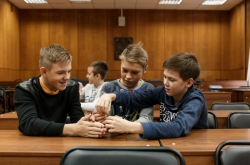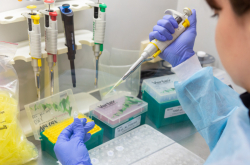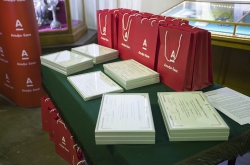Go Green in the City competition
The competition’s tasks are designed to provide the participants with full freedom of action. For instance, for the No Boundaries task, the participants had to propose a solution for reducing energy waste in cities, no specifications given. Other tasks required them to create digital products to improve urban ecology, or use IoT and cybersecurity tech to improve the quality of urban environments.
The Schneider Electric company works in not just the field of power industry, but also metals industry, mining industry, mechanical engineering, wastewater disposal, development of cloud technologies, and Internet services. Its headquarters are in Paris, with branch offices located all across the globe, Russia and the countries of CIS included. This is why the competition is conducted in several stages that take place throughout the year. The finals usually take place at one of the major offices. The competition’s winners get the opportunity to be employed by the company and bring their projects to life; runner-ups with the most interesting solutions also get mentorship from the company’s representatives and may work on implementing their ideas at Schneider Electric. The company actively collaborates with higher education institutions and is highly interested in the development of innovations, as well as employing promising young specialists.
“I found the information about the contest on our university’s webportal. It was published by the Project Management and Promotion Center, whose specialists helped us with organizational issues. I suggested to my colleague, Violetta Savoscula, that we apply for the competition. In collaboration with our research advisor, head of the Department of Industrial Ecology and Safety Olga Sergienko, we came up with the general idea and concept for the project,” comments Anastasia Pavlova.

The winning project
For several years, the Department of Industrial Ecology and Safety has been conducting research on the use of thermoelectric modules with the goal of increasing the efficiency of traditional energy sources. Violetta Savoscula and Anastasia Pavlova proposed using such a module in inland water transport in order to increase the efficiency of diesel-fuel generators.
The module’s operating principle is based on the Seebeck effect, in which electricity emerges in a complete electrical circuit made of dissimilar conductors. When the junctions of these conductors have different temperatures, electricity is produced.
“We proposed fixing the exhaust pipe of a river craft with thermoelectric modules. One side of a system of such modules is heated by exhaust gases, and the other is cooled by surrounding water. This way, we have the difference in temperatures that is necessary for producing electricity. We sent the expert committee a SWOT analysis, a feasibility study, a carbon footprint estimation and forecasts for the development of this alternative energy source. We succeeded in proving that this project is not just cost-effective, but also ecologically relevant,” comments Violetta Savoscula.

The operating principle of thermoelectric modules was invented some 200 years ago, but didn’t become widespread at the time due to underdevelopment of semiconductor technology. Nowadays, thermoelectric modules are used in water coolers, radionics, thermostabilization in gas and oil pipelines, and there are many more fields it can be also applied in.
Taking part in the competition
More than 160 teams from Russia and the CIS applied for the regional stage of the competition. Based on the results, the jury selected eight teams that competed for the winning position by presenting their projects remotely via Skype. Prior to the presentations, each team got mentorship from Schneider Electric representatives. The mentors’ main task was to help the teams transform their ideas into viable business projects.
Among other solutions presented to the jury were projects on creating lightning farms, using drones to detect breakdowns in transmission lines, developing software for designing energy-efficient buildings, and several others.
“We we given 10 days to prepare our presentation. The requirements were also very strict; we only had 10 minutes to present the project and prove that it is the best, the most innovative and the most promising. The jury included members of the company’s different departments, so we had to explain the essence of our project in simple and comprehensible terms while giving eye-catching examples,” remembers Violetta Savoscula.

The team succeeded and won thanks to three aspects of their project and presentation. First of all, their idea was aimed at reducing energy waste and was innovative, which complies with Schneider Electric’s goal. Secondly, the presentation demonstrated the economic effect from introducing the module and its specifications. Lastly, Violetta and Anastasia came up with a spectacular interactive element for their presentation.
“The success of any project is based on two aspects: the project’s innovative nature and a high-quality, memorable presentation. We decided to associate our project with the World Cup. We used this theme for our project’s name, GoalTEC, the design of our presentation, and an interactive element that we added in our presentation’s ending. We took a football and said “We cheered for football during the World Cup; we also cheer for energy efficiency! This ball represents our idea. And we pass it to you, so that you can score it in the goalposts of energy efficiency!” Then, we threw it at the camera, and our mentor who was at Schneider Electric’s office in Moscow threw his own football and scored a symbolic goal. This memorable element had a great effect and got the jury’s applause,” says Anastasia Pavlova.
What’s next?
As their award for winning the regional stage of Go Green in the City, Violetta and Anastasia will visit Schneider Electric’s head office in Paris this September. For now, the team awaits further instructions. They were also invited to a conference where Schneider Electric presented their new products. At the event, the members of ITMO’s Department of Industrial Ecology and Safety acquainted themselves with the company’s fields of focus, as well as discussed the future opportunities for developing their project with Schneider Electric’s representatives.
“Participation in such competitions offers young scientists a unique chance to present their projects for expert evaluation. We are really happy that our idea on reducing energy waste by using thermoelectric modules received support. We believe that the project will be implemented, and its concept will be applied in many different fields,” concludes Violetta Savoscula.




